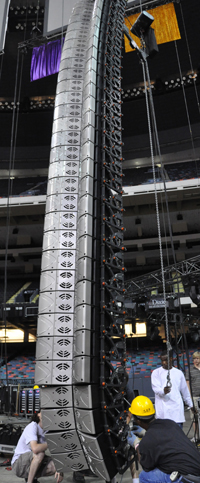
Making Arrangements
So here’s the deal, at least as I see it. With current technology, it’s necessary to utilize multiple loudspeakers to cover large spaces, as no one makes a single loudspeaker that is loud enough, sounds great, and versatile enough to handle a wide range of venues/coverage areas.
These multiple loudspeakers need to be arranged in some sort of configuration that is horizontal, vertical, both, or even one behind the other. Currently, we can get loudspeakers to sum together quite well – but not perfectly. We can also get them to zone together quite well – but not perfectly.

Our ears are very sensitive to those imperfections in the horizontal domain and considerably less sensitive to those same imperfections in the vertical domain. Therefore, the true design advantage that line arrays posses is that they take advantage of the human deficiencies in vertical hearing by keeping their imperfections in the plane where we less likely to perceive them, presenting a low degree of component-to-component imperfections.
Combine this with the fact that they hang nicely, like a string of beads, and I venture to say that line arrays may just be a bit more than the latest fad.
As far as the question — “what’s the next big thing?” — well now, that is the million-dollar question, isn’t it?
My bet is that it will be a technology that better adapts the way music is presented with the way we hear it. Or, of course, it might just be something cheaper, smaller and more convenient with a sonic downside, like the MP3 format.
